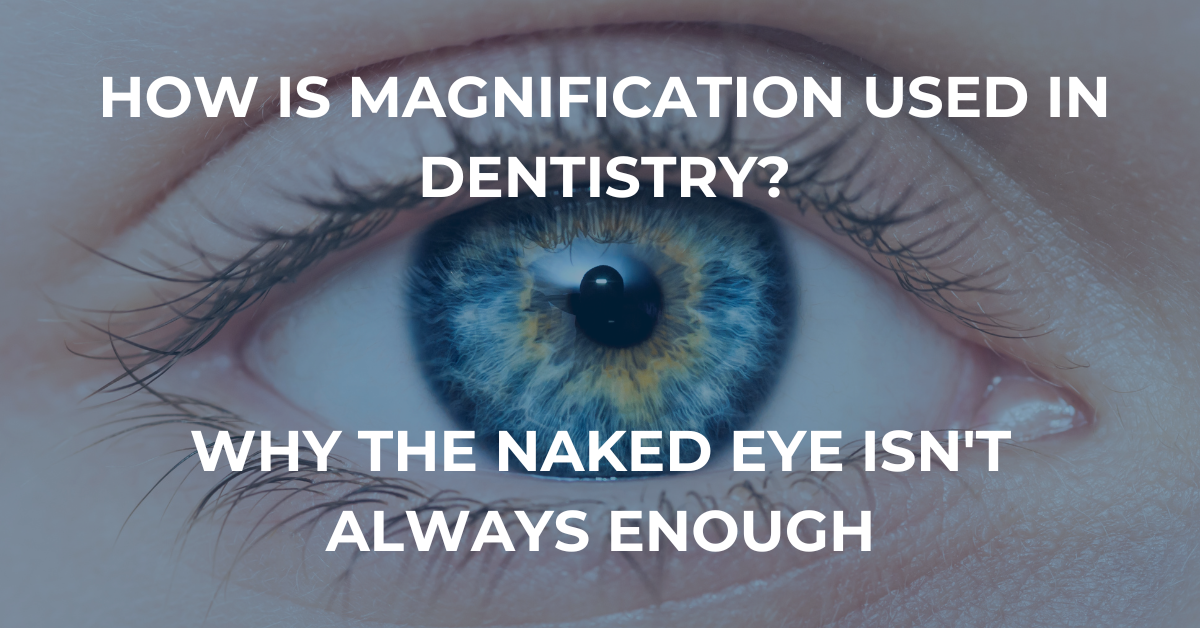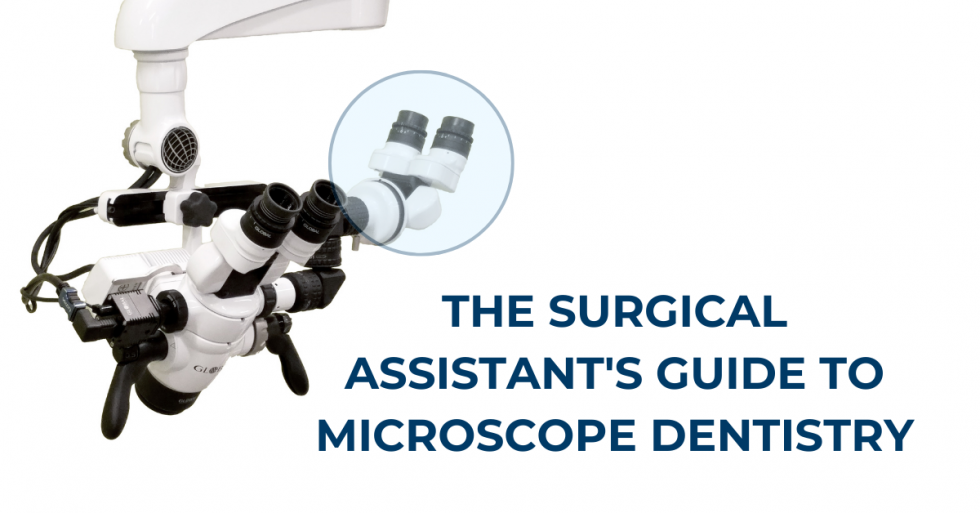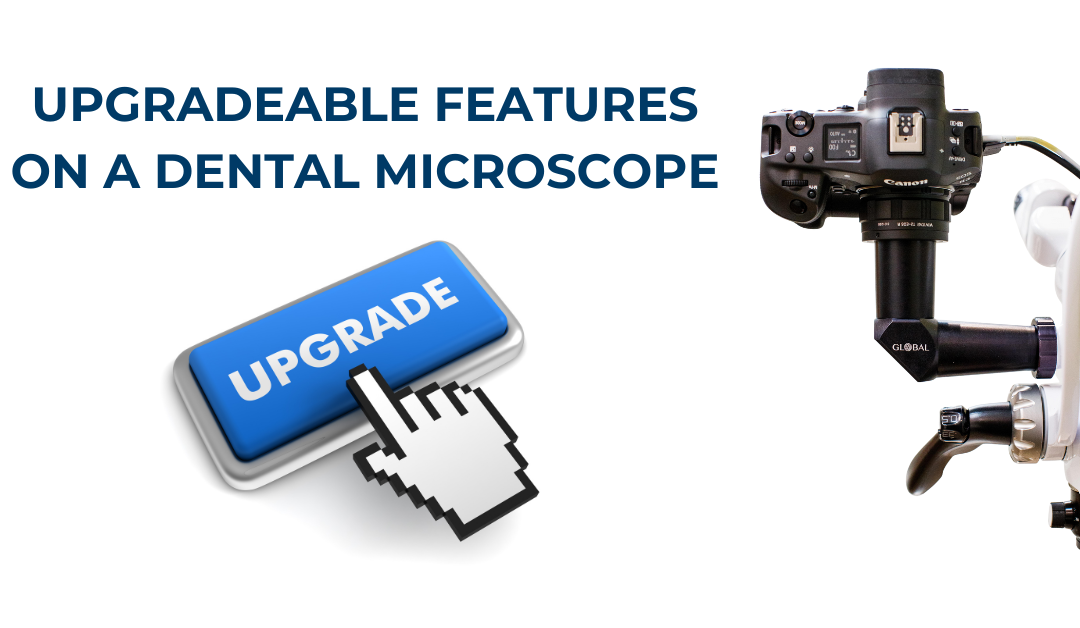How is Magnification Used in Dentistry? Why the Naked Eye Isn't Always Enough

We got into the microscopy business over 25 years ago because we strongly believed magnification would make a huge impact on the field of dentistry. Over the years, numerous research studies set out to observe the effectiveness of magnification over the naked eye on particular diagnoses and procedures, such as endodontic therapies and restorative work. As more of these returned with overwhelming support of magnification, we’ve seen greater integration of magnification devices into doctorate programs and training and, ultimately, increased clinical adoption.
Magnification dentistry, primarily conducted through loupes and microscopes, has become synonymous with certain diagnoses and procedures. Today, we’re going to review when to use magnification, how this improves your vision and thereby your precision, accuracy and efficacy as a dental professional.
The Human Eye
Before we dive into magnification, it’s important to understand how our eyes work and where they’re limited, particularly in routine dental work.
Like much of our anatomy, our eyes are made to adapt to various requirements. We can see objects at a great distance, but we can also see up close in great detail. Our eyes can adjust to focus at various distances, using a system of muscles to generate the required refractive power for the lenses of the eyes. Extended contraction of these muscles can cause fatigue.
In many dental procedures, the ability to see fine details impacts the precision of our diagnoses and treatment. When looking at fine details, we typically need to get closer or move the object closer to narrow our angle of view and minimize eye fatigue. This is why a dentist has to bend down over the patient’s oral cavity in order to be able to see details at a distance of approximately 30 cm. And, as a result of needing to maintain this distance, over time this often creates physical problems with the neck and back.
As we age, so will the distance to see clearly. Most people will find their eyes becoming presbyopic, meaning the eye’s ability to accommodate shorter distances deteriorates and we can no longer focus as well on near objects.
Magnification helps overcome our eye’s natural limitations by effectively bringing objects closer to the eye. You can see all detailed structures, regardless of age, by adjusting magnification settings found on some varieties of loupes, and most microscopes. And, with magnification, your eye muscles can relax, reducing your fatigue.
Stereoscopic Vision – What Is It & Why Is It Important?
The fact that we have two eyes that are adjacent to one another forms our stereoscopic vision. Our left and right eyes perceive a particular object from two different angles (parallax). Our brains then put these two slightly different sets of visual information together to form a 3D image. This allows us to see the third dimension, to estimate distance, size and position and to orientate ourselves.
When dentists are looking at a treatment area, our ability to see three-dimensional images helps inform where our instruments are in relation to an anatomical structure. This is why modern magnification devices are designed to capture our brain’s natural ability to form stereoscopic vision, by enhancing the visualization of both eyes in unison.
Magnification in Dentistry
So, by understanding how our eyes and brain work together to help us adapt to the environment around us, it’s clearer to see how magnification helps us in dentistry. Just like a dental X-ray or CBCT helps us see the anatomy we’re unable to see with the naked eye, loupes and dental microscopes are designed to enhance our natural vision to such a degree that you’re more effective at detecting finer details like cracks, caries and other structures.
Plus, as an added bonus, your eyes are less fatigued at the end of a work day. And, ideally, your entire body takes less of a physical toll because you’re able to position your magnification equipment to require less strain on your neck and back. The magnification effectively helps you reduce the distance for your line of sight when seeing details up close.
To explore many of the top ways dental professionals are using magnification through dental microscopes, continue reading: Top 5 Uses for a Dental Microscope.
When viewing a patient’s oral cavity, you have limited space to position your patient and still see finer detail. Also, shadows present in the oral cavity can impact your ability to see every anatomical structure you’ll need to be able to see during routine dental work. Even with the highest power overhead lamps, shadows are a major inhibitor of accuracy and precision. This is why illumination through loupes or microscopes is critical for getting the best results for your detailed vision.
To see how illumination impacts the effectiveness of magnification in dentistry, continue reading: Dental Magnification & Illumination.
Magnification: Loupes vs Microscopes
In dentistry, the first introduction into the world of magnification is generally through loupes. While loupes fulfill some of the aforementioned benefits of magnification over the naked eye, they are still limited in providing higher magnification levels, illumination, and improved ergonomics.
Loupes generally offer 2X-6X magnification (limited brands offer up to 10X) for general dental procedures. While an overview of the mouth can be seen at these lower magnifications, detailed structures can be viewed better using the higher magnification of a dental microscope, such as locating a root canal, or detecting cracks or caries.
While older loupe technologies only allowed for one power of magnification, newer styles provide the ability to shift between magnification levels on the fly. With proper training, your ability to shift between magnification levels helps dentists switch from overview visualization to detailed viewing quickly and efficiently without moving your head or neck.
Since loupes are worn on your head, this fixed focus follows your every movement. For the duration of the movement, your field of view is blurred to a greater or lesser extent. You then need to find the correct working distance to enjoy a fully focused image again. Dental microscopes, on the other hand, are mounted to stabilize your positioning and ability to focus on finer details for longer durations.
The ergonomics of a dental microscope are another key benefit over loupes. With a scope, you can sit completely upright, focusing all of your movements on just the fine motor functions of your forearms and hands. Once you get a microscope positioned correctly for your patient, you can make very small adjustments to keep the device in optimal focus, without having to raise or lower the entire scope.
Lastly, loupes are not designed to improve every aspect of our eye’s natural abilities. Loupes may still cause eye fatigue because your eyes must look inward (converge) to focus on a close-up object. This results in eye strain and headaches. In microscopes, the design of the optics allows you to look straight ahead with both eyes, reducing strain.
For our full side-by-side comparison of these two popular magnification devices, continue reading: Dental Loupes versus Microscope: 5 Key Categories.
More Value With a Global Microscope
At Global Surgical, we’re committed to providing dentists with the best value and satisfaction through our modular designs (ready for future upgrades), and including the industry’s only limited lifetime warranty.
Many of the doctors we speak with quickly begin using their scopes with nearly every patient – from observation and diagnosis to treatment and procedure, so we know it’s important they are able to be operational every single day for years to come. But don’t just take our word for it, hear from doctors who have used Global microscopes in their practices:
- “When you see something magnified with amazing illumination you are transported to a different world.” – Dr. Gurpreet Khurana, DMD
- “The visual and lighting enhancement provided by the operating microscope opens a whole world of therapeutics for my patients benefits.” – Dr. Jeffrey Krupp, DDS
- “My scopes provide shadow less light into the hard to see areas that I as a dentist have to overcome every day. The scopes provide visualization of difficult angles that were very difficult for me to see and access in the past.” – Dr. Stacey Ochoa, DDS
- “Not only have my neck and back issues subsided, but with the better lighting and magnification that I now have, I am able to diagnose and treat dental problems better (and earlier)! I see things now that I know I would have missed without the microscope.” – Dr. Doug Hanneman, DDS
Ready to Explore? Reach Out!
If you’re looking to get started with magnification, or considering adding a microscope to your practice, we are here to help! As one of the first companies to focus on dental microscopy, founded over 25 years ago, we’ve been helping dental practices see the benefits of high magnification through a dental microscope. Plus, we’re the only dental microscope manufacturer based in the US, where all of our assembly and manufacturing is done as well.
Please feel free to reach out at 800-861-3585 or by clicking the button below.



